
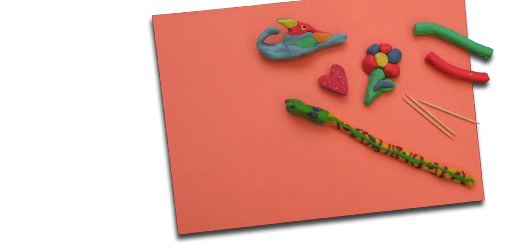




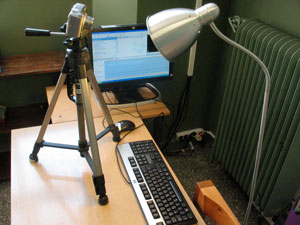
- Plasticine
- Paper or cardboard (optional)
- Markers or oil pastels (optional)
- Adhesive tape
- Digital photo camera
- Tripod
- Computer with installed video editing software
- Lighting - table or floor lamp (optional)


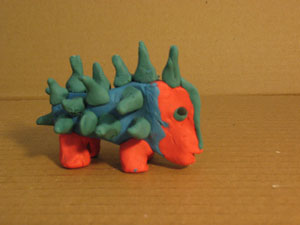
- To produce a moving image film using plasticine, you first have to make your own character figures. These figures can be anything! You can create people, real or imaginary animals, fairies and elves, dinosaurs and monsters or anything else you think of! It’s fun work with your friends!
- You might want to create a background and environment: flowers, trees, rocks or whatever you think would suit your characters.
 Your figures should be able to stand on their own and shouldn’t fall over when placed on the table.
Your figures should be able to stand on their own and shouldn’t fall over when placed on the table.
 In order to help wobbly figures stand, insert and support them with toothpicks or pipe cleaners.
In order to help wobbly figures stand, insert and support them with toothpicks or pipe cleaners.

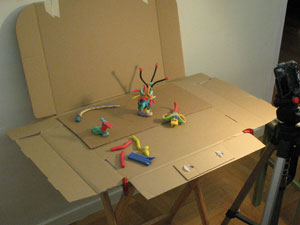

- Your stage set can be a simple table surface and the wall behind as a backdrop.
However, you might like the idea of using paper or cardboard to cover the table and wall surfaces. Your set will have to be stable, so use adhesive tape to keep the paper from moving. You can use different types of paper. Try drawing or painting it! -
Place the plasticine characters, and everything else you want to appear at the beginning the film, onto the stage set. Tape down anything that will not move (making sure the tape does not show).



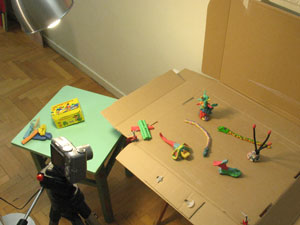
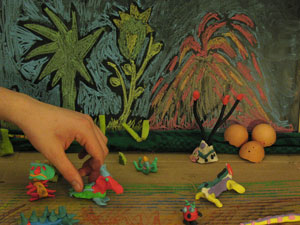

- Secure the camera onto the tripod. Adjust the tripod to face your stage set. Look into the camera screen. Do you like what you see? Try out different viewpoints by adjusting the tripod and changing the position of the camera. Play around by placing the tripod more to the left or right and adjusting the camera lower down or higher up.
 Try using the camera zoom to get closer or move away from your stage set.
Try using the camera zoom to get closer or move away from your stage set. - Have you though about the plot? It’s a good idea to think about what you want to happen in your film.
What will move? How fast will it move? Will other characters or objects move at the same time? Best be simple the first time! Move one, maximum two, plasticine figures and try something more complicated next time. - Spend some time on the lighting. Make sure that no surrounding objects, the tripod or even you cast shadows on your stage set. If you want, you might try lighting the set with a portable lamp to one side.
 Make sure your lighting is constant. All photographs should have the same lighting to make sure that some are not brighter than others. Later on, when you are more experienced, you can try changing the lighting, on purpose and for specific effects, within a sequence.
Make sure your lighting is constant. All photographs should have the same lighting to make sure that some are not brighter than others. Later on, when you are more experienced, you can try changing the lighting, on purpose and for specific effects, within a sequence. - When everything is ready it’s time to start photographing!
You’ve already read Before Starting, so you know that while photographing your scene, the camera and the tripod have to be absolutely stable. Watch out! It’s easy to kick the table or tripod by accident.
Take the first picture of the sequence with everything arranged just as you’ve set it up. Then, slightly move the figures that you want to animate and take the next photograph. Move the figures again and take another photograph Keep doing this until all your figures have done what you want them to do.
It is very important to make small moves between taking each picture. Experience will help you get a better feeling for how much to move your figure each time.
 It is much easier and fun to work with friends! If there are two of you, one can take the photographs and the other can move the plasticine figures. If you are three, one can take the photos while the other two each move a figure.
It is much easier and fun to work with friends! If there are two of you, one can take the photographs and the other can move the plasticine figures. If you are three, one can take the photos while the other two each move a figure.
 Try transforming you figure as well as moving it. Plasticine is a soft material so you can easily change the shape of a figure during the film. Just make sure that the changes are not too big from one photo to the other. When you have finished photographing your entire sequence, remove the camera from the tripod. Transfer your photos into a folder in your computer
Try transforming you figure as well as moving it. Plasticine is a soft material so you can easily change the shape of a figure during the film. Just make sure that the changes are not too big from one photo to the other. When you have finished photographing your entire sequence, remove the camera from the tripod. Transfer your photos into a folder in your computer
 It is a good idea to name your project folder with a name which reminds you of the sequence you have just photographed e.g. running monsters.
It is a good idea to name your project folder with a name which reminds you of the sequence you have just photographed e.g. running monsters.
Your characters and figures appear to move when you view the photos you took very quickly one after the other.
For this you will need to use video editing software. Many computers have this software already installed and, if not include a program that can be downloaded from the internet. Read about how to edit your film in the Before Starting chapter.
If you are trying to make moving image films for the very first time, it is best to start with short and simple sequences.
As soon as you gain more experience, you can edit together more than one sequence for your film.

On the left are examples of drawn animation projects created by primary school children in workshops led by Christina dePian.
Bellow, are links to examples of short animation videos on the internet created by children, students and/or amateurs. Further down, are examples of work by professionals and some classics of drawn animation.
Have a look and use these videos as a sourse of inspiration and ideas.
Contact us when you have created your own animation projects.
We are looking forward to seeing them!
Videos created bt children, students and amateurs:
- Run Voula Run - workshops at UNIMA Hellas
- The square's tale - 5th grade students/ Galatsi, Greece
- Biolea workshop 1 - at BIOLEA
- Short film creted by children-
supported by ΚΙΝΟglaz and "Free and Real" - Sources of Energy - 6th grade students/ Ermoupolis, Greece
- Rana
- Say No to Bullying
- Counting to 10
- Abstract 0.5
- The playful kittens
- Bubble gum guy
- Playing with water
- Breakdance
- Make a face
- Morph - fishcake by J.K.
- Penguin - Fishing fiasco
- Poke
Videos created bt professionals:
- Mio Mao - the spider
- Clay play
- Plonsters - the lonely island
- Purple & Brown 'Scales Balls' clip
- The Animals save the planet - Elephant shower
- Creature comforts - Nick Park
- Gumby
- Plastilinovaya Vorona
